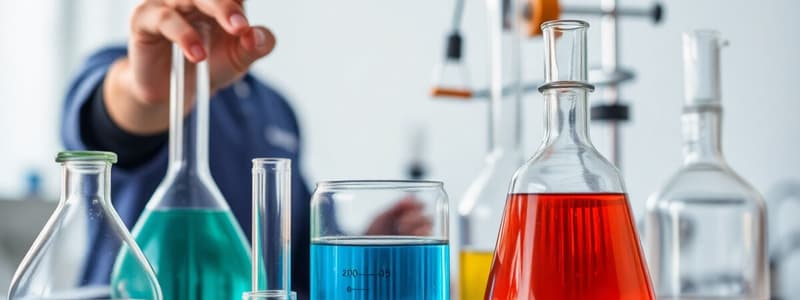Podcast
Questions and Answers
Which of the following best describes the definition of chemistry?
Which of the following best describes the definition of chemistry?
What are the two main classifications of matter?
What are the two main classifications of matter?
How does chemistry contribute to civil engineering?
How does chemistry contribute to civil engineering?
Which of the following is true about the scientific method in chemistry?
Which of the following is true about the scientific method in chemistry?
Signup and view all the answers
What distinguishes pure substances from mixtures?
What distinguishes pure substances from mixtures?
Signup and view all the answers
Which statement about chemistry's role in environmental solutions is correct?
Which statement about chemistry's role in environmental solutions is correct?
Signup and view all the answers
What is considered the 'central science' and why?
What is considered the 'central science' and why?
Signup and view all the answers
In the scientific method, what follows the observation stage?
In the scientific method, what follows the observation stage?
Signup and view all the answers
What is the definition of mass in terms of matter?
What is the definition of mass in terms of matter?
Signup and view all the answers
Which of the following describes intrinsic properties of matter?
Which of the following describes intrinsic properties of matter?
Signup and view all the answers
Which property is considered an extensive property?
Which property is considered an extensive property?
Signup and view all the answers
What distinguishes chemical properties from physical properties?
What distinguishes chemical properties from physical properties?
Signup and view all the answers
Which of these states of matter has a definite shape?
Which of these states of matter has a definite shape?
Signup and view all the answers
What is the relationship between temperature and kinetic energy in gases?
What is the relationship between temperature and kinetic energy in gases?
Signup and view all the answers
Which of the following represents a symbolic perspective in chemistry?
Which of the following represents a symbolic perspective in chemistry?
Signup and view all the answers
Which statement about extrinsic properties is correct?
Which statement about extrinsic properties is correct?
Signup and view all the answers
What is a characteristic of gases compared to solids and liquids?
What is a characteristic of gases compared to solids and liquids?
Signup and view all the answers
Which of the following best describes a macroscopic perspective of matter?
Which of the following best describes a macroscopic perspective of matter?
Signup and view all the answers
What characteristic distinguishes a pure substance from a mixture?
What characteristic distinguishes a pure substance from a mixture?
Signup and view all the answers
Which statement accurately defines an element?
Which statement accurately defines an element?
Signup and view all the answers
Which of the following is an example of an inorganic compound?
Which of the following is an example of an inorganic compound?
Signup and view all the answers
What is a property of metals?
What is a property of metals?
Signup and view all the answers
Which best describes the law of definite proportions?
Which best describes the law of definite proportions?
Signup and view all the answers
Which of the following is an example of a homogeneous mixture?
Which of the following is an example of a homogeneous mixture?
Signup and view all the answers
What is the primary difference between physical change and chemical change?
What is the primary difference between physical change and chemical change?
Signup and view all the answers
Which reaction is characterized by heat release to the surroundings?
Which reaction is characterized by heat release to the surroundings?
Signup and view all the answers
What type of mixture is characterized by the Tyndall effect?
What type of mixture is characterized by the Tyndall effect?
Signup and view all the answers
What is the role of the law of conservation of mass in chemical reactions?
What is the role of the law of conservation of mass in chemical reactions?
Signup and view all the answers
Study Notes
Introduction to Chemistry
- Chemistry is a branch of physical science that studies the composition, properties, and changes of matter.
- It's sometimes called the central science because it connects physical, life, and applied sciences (like medicine and engineering).
- Chemistry is an empirical science, studied through measurement of physical properties.
- The field of engineering benefits significantly from chemistry.
Intended Learning Outcomes
- Students should be able to explain how chemistry's role connects to engineering.
- Explain the scientific method.
- Understand chemical concepts at different levels (macroscopic, microscopic, and symbolic).
- Describe properties of matter (intrinsic, extrinsic, and measurable).
- Classify matter (mixtures, pure substances, elements, compounds).
- Compare and contrast solid, liquid, and gas states.
- Differentiate between physical and chemical changes of matter.
Accreditation Board for Engineering and Technology (ABET)
- ABET is a professional organization overseeing engineering education.
- ABET defines engineering as the application of mathematical and natural sciences (gained through study, experience, and practice) with judgment to economically use natural materials and forces for humanity's benefit.
Definition of Chemistry
- Chemistry involves the study of matter's composition, properties, and transformation.
- Chemistry is the central science because it connects other fields of study.
Significance of Chemistry
- Chemistry is crucial in engineering design, selection of materials, and understanding electron flow as a foundation for electricity (in electrical engineering).
- Chemistry is essential in the manufacturing process of various products (food, beverages, pharmaceuticals, plastics).
- Chemical advancements and research are crucial for developing new technologies, like drugs and alternative energy sources.
- Chemical knowledge is essential for understanding and creating solutions to environmental issues.
Scientific Method
- Chemistry is a science that utilizes the scientific method.
- The scientific method is a systematic and orderly approach to research to answer questions about the world.
- Steps in the scientific method include observations, hypothesis formulation, constructing experiments, and analyzing results to support or reject the hypothesis.
Models in Science
- Models offer a largely descriptive view of phenomena, like the relationship between gas pressure and temperature.
- Theories offer explanations grounded in more fundamental principles or assumptions about systems.
Matter and Energy
- Matter occupies space and has mass.
- Matter is composed of tiny particles called atoms.
- Mass is a measure of matter, while weight is the gravitational force exerted on an object.
Levels of Understanding/Perspective
- Macroscopic perspective: observing matter, describing properties.
- Microscopic perspective: considering matter's atomic composition and structure.
- Symbolic perspective: using chemical symbols and formulas to represent matter and reactions.
Properties of Matter
- Intrinsic properties are inherent to a substance (e.g., melting point, density, colour).
- Extrinsic properties describe a substance's external qualities (e.g., size, shape, mass, volume).
- Measurable properties are quantifiable, either extensive (dependent on sample size - e.g., mass) or intensive (independent of sample size - e.g., boiling point).
- Physical properties can be observed and measured without altering a substance's identity.
- Chemical properties are observed during chemical changes.
States of Matter
- Solids have a definite shape and volume.
- Liquids have a definite volume but take the shape of their container.
- Gases have neither a definite shape nor volume; they take the shape and occupy the volume of their container.
Classification of Matter
- Matter can be categorized into mixtures (mixtures have variable substance composition) or pure substances (pure substances have a constant composition).
- Pure substances can be further classified into elements and compounds.
- Mixtures can be further divided into a) heterogeneous mixtures (uneven distribution of substances, e.g., sand in water), and b) homogeneous mixtures (evenly distributed substances, e.g., sugar in water).
Pure Substance
- Pure substances contain only one type of matter and have constant composition.
- Pure substances can be elements or compounds; elements are fundamental units, while compounds are combinations of elements.
Element
- Elements are substances composed of only one type of atom.
- Elements are the simplest form of matter.
- 115 known elements exist.
- Elements are represented by chemical symbols
Compounds
- Compounds are substances composed of two or more elements in a definite proportion by mass, forming a molecule.
- Compounds have unique properties different from their constituent elements.
- Compounds are represented by a chemical formula.
Organic Compounds
- Organic compounds contain carbon, and are common in living organisms.
- Examples include hydrocarbons (methane, CH4), sucrose (C12H22O11), and ethanol (CH3CH2OH).
Inorganic Compounds
- Inorganic compounds do not contain carbon.
- Examples include sodium chloride (NaCl), water (H2O), and sulfuric acid (H2SO4).
Mixtures
- Mixtures are combinations of two or more substances that retain their individual properties.
- Mixtures are not represented by a chemical formula.
- Mixtures can be classified into homogeneous (uniform composition, e.g., sugar solution) and heterogeneous mixtures (non-uniform composition, e.g., sand and water).
Changes in Matter
- Physical change alters the form or state of a substance without changing its composition.
- Chemical change alters the structure and composition of a substance. It involves a chemical reaction.
- Chemical changes can release or absorb heat (exothermic/endothermic).
Laws of Conservation
- The Law of Conservation of Mass states matter isn't created nor destroyed in chemical reactions.
- The Law of Conservation of Energy states that energy cannot be created or destroyed, only transformed into different forms.
Forms of Energy
- Energy is the capacity to do work.
- Forms of energy include kinetic energy (energy of motion), potential energy (energy of position), radiant energy, thermal energy, chemical energy, and nuclear energy.
Studying That Suits You
Use AI to generate personalized quizzes and flashcards to suit your learning preferences.
Related Documents
Description
Explore the fundamental concepts of chemistry and its essential role in engineering. This quiz covers the scientific method, properties of matter, and classification of materials. Understand the connections between chemistry and various fields such as medicine and engineering to grasp the empirical nature of science.




